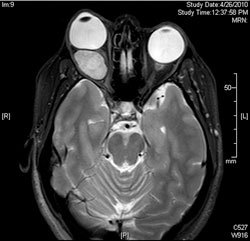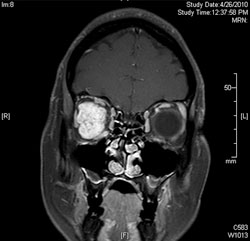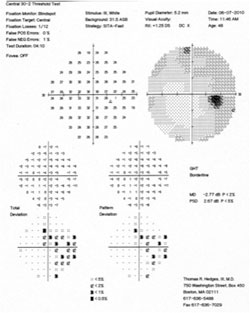Woman referred for bulging of right eye
The patient was found to have an intraconal mass.
 Priti Batta |
 Namrata Nandakumar |
A 49-year-old otherwise healthy woman was referred to the neuro-ophthalmology clinic at Tufts New England Eye Center with a chief complaint of bulging of her right eye over the course of 10 years. The patient described a rather indolent course but said the bulging had become more noticeable and had begun to interfere with her vision in the past year. She noted patchy gray areas in her peripheral vision of the right eye but no diplopia. In the extreme left and right gaze, she noted straining of her eye muscles. She had been experiencing headaches associated with stress for years without recent change or localization.
Her ocular history was remarkable for moderate myopia, for which she had LASIK surgery 2 years prior with good visual result. She was generally healthy and took only a multivitamin daily. She denied a diagnosis of thyroid disease or associated systemic symptoms.
On examination her best corrected visual acuity was 20/25 in the right eye and 20/20 in the left eye. Color vision was normal, and there was a very slight reduction in contrast sensitivity in the right eye. A slight relative afferent pupillary defect was detected in the right eye. Ocular motility testing showed a minimal left hyperphoria that was detected in most directions of gaze. External examination was significant for increased scleral show both superiorly and inferiorly on the right with obvious proptosis. Hertel exophthalmometry revealed measurements of 26.5 mm in the right eye and 18 mm in the left eye. Anterior and posterior examinations of the eyes were otherwise normal, including healthy-appearing optic nerve heads without swelling, pallor or collateral vasculature.
 Axial MRI of the orbits with T2 fat saturation. |
 Coronal MRI of the orbits with T2 fat saturation. Images: Lazzara M, Heher K and
Hedges TR |
|
|
Automated visual field testing revealed patchy deficits in the temporal field of the right eye and a full field in the left eye. Optical coherence tomography nerve fiber layer measurements were 88 µm and 84 µm, respectively. An MRI of the orbits with gadolinium and fat saturation showed a 2.7 × 1.9 × 2.8 cm intraconal mass of the right orbit with fluid-attenuated inversion recovery and T2 hyperintensity, as well as homogenous enhancement. A pseudocapsule on T1 imaging as well as internal septations were present. There was significant medial displacement of the optic nerve and a mass effect on the posterior aspect of the globe.

What is your diagnosis?
Intraconal mass causing painless proptosis
Given this patient’s history and the MRI findings, a presumed diagnosis of orbital cavernous hemangioma was made. Other possible etiologies of an intraconal mass causing painless proptosis with these radiographic findings include cavernous lymphangioma and schwannoma.
Lymphangiomas generally present at a younger age. They can result in sudden onset of globe displacement, strabismus and optic nerve compression due to intrinsic hemorrhages. On MRI they can be situated intraconally or extraconally with a heterogeneous and multiloculated appearance and variable enhancement. Schwannomas are rarer tumors and are typically extraconal and iso-intense to muscle on T2 imaging. Additional intraconal lesions such as meningiomas, optic nerve sheath gliomas and lymphomas may have an indolent course but appear radiographically distinct.
Cavernous hemangiomas, or cavernomas, are benign congenital lesions that typically become symptomatic in the second to fifth decade of life. They are the most common primary orbital tumor seen in adults, representing 50% of orbital vascular tumors. The majority of the patients are women, presumably due to the expression of progesterone receptors on the epithelial cells of the tumor. Painless, gradual, unilateral exophthalmos is the most common presenting complaint, with visual changes (eg, blurred vision, field defects, diplopia) developing once the tumor enlarges enough to cause a mass effect on surrounding structures. Optic nerve compression, limitation of extraocular motility from muscle displacement and choroidal folds from posterior globe displacement are also possible findings.
Radiographically, cavernous hemangiomas are round to oval intraconal masses with a homogenous appearance. On MRI, the lesions are iso-intense with respect to muscle on T1 and are hyperintense on T2. Molding of the globe and/or bone can occur depending on the size of the lesion, and calcification and signal voids within the tumor secondary to phleboliths may be present. Most tumors are found intraconally within the temporal or superior temporal regions. Histopathologically, the lesions consist of largely dilated and thrombosed septated venous spaces with a surrounding compact capsule.
Prognosis for cavernomas is generally very good. Case reports of spontaneous hemorrhage do exist but are rare. Spontaneous hemorrhage is more frequent in the case of intracranial cavernomas. Treatment options include observation in the case of minimal symptoms without evidence of nerve compression and surgical excision. Scheuerle and colleagues described 20 patients, of whom 15 underwent excision for signs of orbital compression. Improvement of visual acuity following surgery was noted in six of eight patients with preoperative changes. Two of three patients with preoperative visual field deficits had some resolution, and diplopia remitted in three of three patients.
Surgical techniques include transconjunctival excision for small tumors, lateral orbitotomy for those tumors confined to the lateral aspect of the orbit and, less commonly, a transcranial approach for lesions superior and medial to the optic nerve. In most cases, the tumor can be excised en bloc with an intact capsule. No reported cases of recurrence after excision, even in the case of incomplete excision, have been reported. Surgeons should be aware and patients likewise cautioned preoperatively that despite the clinical and radiologic appearance, the possibility exists that the lesion may in fact be an atypical lymphangioma or schwannoma, thereby complicating surgical extraction.
Diagnosis and management
Our patient presented with marked painless proptosis, and MRI showed considerable displacement of the right optic nerve and indentation of the globe. Based on the patient’s history, clinical exam and radiographic testing, a diagnosis of cavernous hemangioma was made. Definitive automated field changes, a relative afferent pupillary defect and new complaints of visual disturbances suggested optic nerve compromise. It is worth noting that the discrepancy between the size of the lesion and symptoms speaks to the exceedingly slow, progressive nature of these lesions and helps in diagnosis of this benign entity.
Following extensive discussion and oculoplastic evaluation, our patient underwent a lateral orbitotomy with isolation of the lacrimal gland and lateral rectus. The mass was excised without complication using blunt dissection and traction sutures. A cavernous hemangioma was confirmed on pathology review. Three weeks postoperatively the patient was doing very well, with resolved proptosis, minimal discomfort and no negative visual sequelae.
References:
- Dutton JJ. Orbital diseases. In: Yanoff M, Duker JS. Ophthalmology. 3rd ed. Philadelphia, PA: Mosby; 2009:1450-1465.
- Scheuerle AF, Steiner HH, Kolling G, Kunze S, Aschoff A. Treatment and long-term outcome of patients with orbital cavernomas. Am J Ophthalmol. 2004;138(2):237-244.
- Selva D, Strianese D, Bonavolonta G, Rootman J. Orbital venous-lymphatic malformations (lymphangiomas) mimicking cavernous hemangiomas. Am J Ophthalmol. 2001;131(3):364-370.
- Matthew Lazzara, MD, Katrinka Heher, MD, and Thomas R. Hedges III, MD, can be reached at New England Eye Center, Tufts University School of Medicine, 750 Washington St., Box 450, Boston, MA 02111; 617-636-4219; fax: 617-636-4866; website: www.neec.com.
- Edited by Priti Batta, MD, and Namrata Nandakumar, MD. Drs. Batta and Nandakumar can be reached at New England Eye Center, Tufts University School of Medicine, 750 Washington St., Box 450, Boston, MA 02111; 617-636-4219; fax: 617-636-4866; website: www.neec.com.


